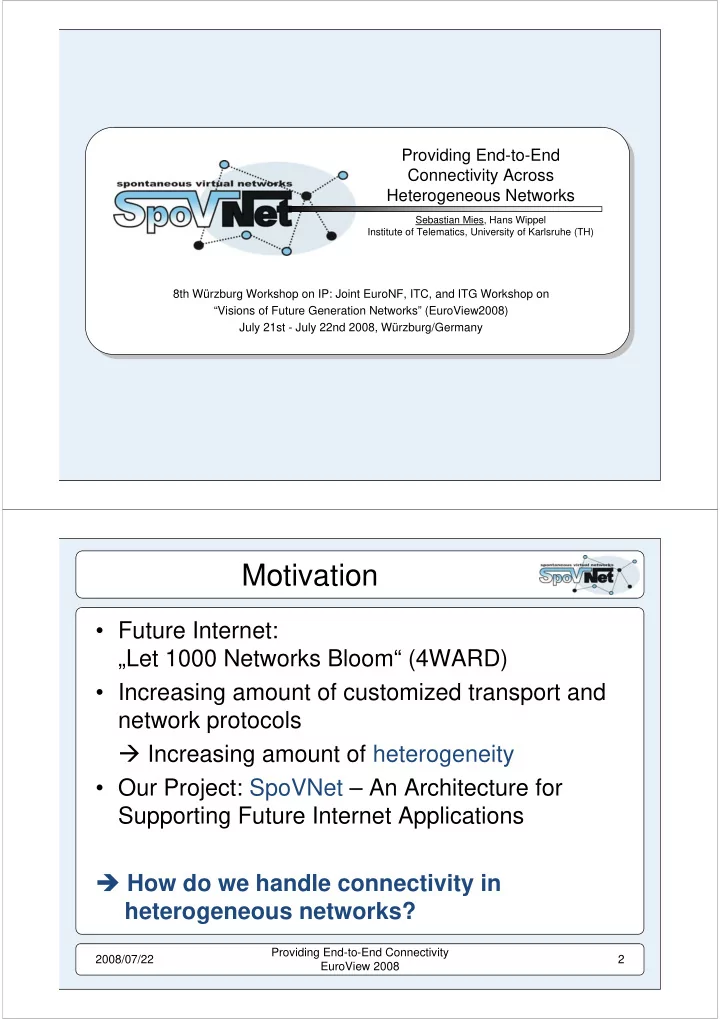

Providing End-to-End Connectivity Across Heterogeneous Networks Sebastian Mies, Hans Wippel Institute of Telematics, University of Karlsruhe (TH) 8th Würzburg Workshop on IP: Joint EuroNF, ITC, and ITG Workshop on “Visions of Future Generation Networks” (EuroView2008) July 21st - July 22nd 2008, Würzburg/Germany Motivation • Future Internet: „Let 1000 Networks Bloom“ (4WARD) • Increasing amount of customized transport and network protocols � Increasing amount of heterogeneity • Our Project: SpoVNet – An Architecture for Supporting Future Internet Applications � How do we handle connectivity in heterogeneous networks? Providing End-to-End Connectivity 2008/07/22 2 EuroView 2008
SpoVNet in a Nutshell IPv4 • Extensible set of services implemented IPv4 by overlays IPv4 – Spontaneous and flexible per application – No infrastructure support required – Self-organizing, scalable and IPv6 robust • Differences to other IPv6 WLAN Overlay-based approaches? IPv4 Hotspot Fixed IPv4 – Framework provides generic Cell (transport-)mechanisms for convenient Base Overlay realization of overlay-based services and Service Overlay 1 Service Overlay 2 innovative applications – Optimization and adaptivity using cross-layer-Information Providing End-to-End Connectivity 2008/07/22 3 EuroView 2008 SpoVNet Architecture provides a framework that 1) allows comfortable creation of application supporting (overlay-)services in heterogeneous networks (e.g., multicast) 2) assures that these services can be incrementally replaced by evolving underlay services (e.g., IP multicast, QoS support) Application Allows to replace SpoVNet services Service abstraction with underlay services New Service SpoVNet services Underlay abstraction Facilitates comfortable creation of new services SpoVNet base Underlay Service Providing End-to-End Connectivity 2008/07/22 4 EuroView 2008
SpoVNet Underlay Abstraction • Provides generic transport mechanisms hiding mobility, multi-homing and heterogeneity 1x per Services Application Underlay abstraction SpoVNet Base 1x per Device Base Overlay • ID-based addressing • ID/Locator mapping • Robust connectivity Base Communication • operates on locator sets • ID agnostic • provides/maintains SCTP TCP UDP direct transport links between nodes IPv4 IPv6 Link Layer WLAN 802.3 UTRAN HSDPA Providing End-to-End Connectivity 2008/07/22 5 EuroView 2008 Connectivity Indirect Relay connectivity A � C IPv4 – LAN Device B Device C Device A IPv4 – ISP A IPv6 – ISP B Direct connectivity A � D WLAN Device D Hotspot Sensor Network Fixed Cell Base Overlay Providing End-to-End Connectivity 2008/07/22 6 EuroView 2008
Connectivity Domains Connectivity Connectivity domain X domain Y IPv4 – LAN Device B Device C Device A IPv4 – ISP A IPv6 – ISP B WLAN Device D Sensor Network Hotspot Connectivity Fixed Cell domain Z Providing End-to-End Connectivity 2008/07/22 7 EuroView 2008 Connectivity Domains • Problem outline – Detect connectivity domains and relays – Establish links across connectivity domains – Consider partitioning and merging • Our first solution – Identification of connectivity domains with probabilistically unique identifiers – Detection of relays – Simple link state protocol finds relay paths Providing End-to-End Connectivity 2008/07/22 8 EuroView 2008
Detection Example Connectivity domain ID=0xa197a.. IPv4 – LAN Device B Choose ID Device C 0xa197a… Device A IPv4 – ISP A IPv6 – ISP B Direct connection WLAN Device D Sensor Network Hotspot Fixed Cell Providing End-to-End Connectivity 2008/07/22 9 EuroView 2008 Detection Example Connectivity Connectivity domain domain ID=0xa197a.. ID=0xf9812.. IPv4 – LAN Device B Device C Relay associations Device A Relay: exchanged with gossiping IPv4 – ISP A 0xa197a.. � 0xf9812.. Routes: 0x19752... � E IPv6 – ISP B Device E Relay: WLAN Connectivity 0xf9812.. � 0x19752.. Device D Hotspot Sensor Network domain Fixed Routes: 0xa197a.. � B Cell ID=0x19752.. Providing End-to-End Connectivity 2008/07/22 10 EuroView 2008
Conclusion • First pragmatic approach allows – Distributed detection of connectivity domains – Provides relay paths to each domain � Provides end-to-end connectivity across heterogeneous networks! • Further work – Algorithms to handle partitioning and merging – Optimization of relay paths with virtual coordinates Providing End-to-End Connectivity 2008/07/22 11 EuroView 2008 Thank you! Questions?
Recommend
More recommend